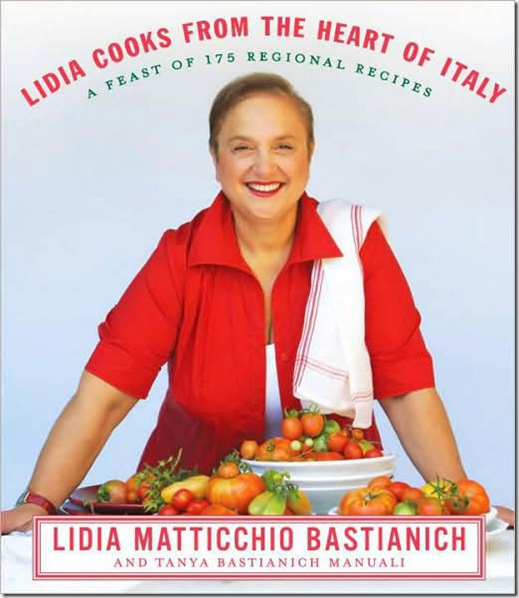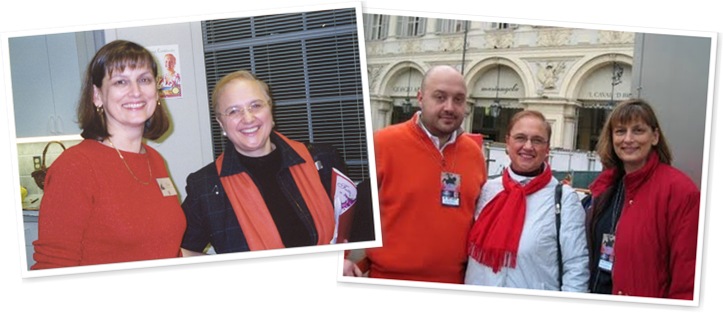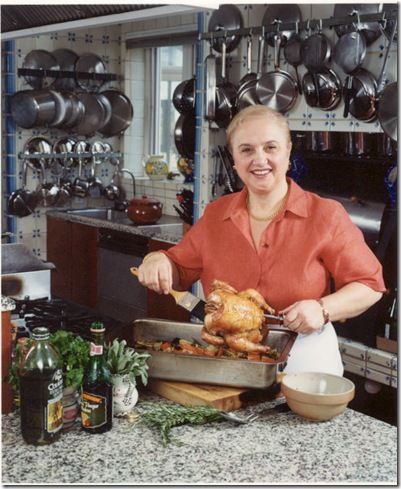 With her natural warmth and love of Italian food and family, she could be your next door neighbor or your Aunt Lidia. Most likely she’s not, but it’s a sure bet that when she calls everyone to the table at the end of her TV show, “Lidia’s Italy,” with her signature, “Tutti a tavola a mangiare,” you’d love to be actually sharing a meal with her and her clan.
With her natural warmth and love of Italian food and family, she could be your next door neighbor or your Aunt Lidia. Most likely she’s not, but it’s a sure bet that when she calls everyone to the table at the end of her TV show, “Lidia’s Italy,” with her signature, “Tutti a tavola a mangiare,” you’d love to be actually sharing a meal with her and her clan.
Lidia Matticchio Bastianich exudes an easy affability and approachability that belies the empire that is Lidia. In addition to her cookbooks, her TV show and her restaurants, Lidia is also owner of a production company, a line of cooking products, co-owner of vineyards in Italy with her son Joe, and of a travel company with her daughter Tanya.
Maybe that’s the key to her success – the age-old mantra of “Find something you love to do and you’ll never have to work a day in your life.” She has honed in on her passion of cooking Italian and Italian-American cuisine in all its guises – from agnello to zabaglione and practically everything in between. In her newest book, “Cooking From The Heart of Italy,” Lidia takes her readers and viewers of her companion TV series on a discovery of recipes from some of the lesser-known villages, towns and regions that may not be as familiar as the well-known haunts of Italy.
I’ve been lucky enough to meet Lidia on several occasions, including once when she graciously agreed to speak at an Italian cultural institution I’m involved with, and once in Turin, Italy where I was working as a journalist during the 2006 winter Olympics.
She was no less generous with her time last week when I interviewed her for Ciao Chow Linda. This is the first of two-part series highlighting Lidia’s newest book, “Cooking from the Heart of Italy,” and some of her thoughts on food, family and her future.
Q. Why did you chose these particular recipes from lesser-known areas for “Cooking From The Heart of Italy?”
A. That’s the intent. Besides I’ve done the other ones. Italy has 21 regions. I’ve addressed some of the more popular ones, if you will. I used to get a lot of requests from people who were Calabrese, for instance, or other regions, to include some recipes from their regions in my books. It was just way overdue.
Q. Where do you draw inspiration for the recipes in your cookbooks and on your show?
A. They’re not my recipes. All of them belong to the Italian patrimony and as I go around, I take note of the little things, whether it’s something from a farmer, a salumaio, a cheesemaker, or a woman cooking at home.
Q. What effect has your background of growing up in Istria and emigrating to Trieste, then the United States had on your cooking?
A. A tremendous effect, in the sense that I think the whole philosophy of being close to food, growing food, having a little garden, started in those early years. For me it became a way of cooking, of living and I think I took it with me to America. In all of Italy, the relationship of the garden and the food that we eat, the markets, shopping on daily basis - that’s a state of mind that maybe is not practiced as much in America but that was so much a part of how I grew up, and what I’m trying to bring to my cooking here. I know that in America it’s hard to go out and shop on a daily basis, but buying local products when they’re available is important and I want to get that across.
Q. What single dish for you evokes best a childhood memory?
A. There are many. The rice we used to cook - with a few leaves of sage, but with oil and a little grana padano. I remember that. It was so comforting and full of taste.
Q. Why do you think it’s important to pass down the recipes for these traditional foods?
A. Americans are looking for a connection. Italy is the number one ethnic cuisine in America. For me, I am once removed (from my ancestors and their recipes in Italy), but I feel that maybe my own children might not have this luxury. I want to put it down because all too often, I hear from people “Yes, my grandfather cooks that recipe, but I never put it down.” These are the recipes. Maybe their relative added a little bit of this or a little of bit of that that is different, but it’s a basic framework for people to use.
 Chicken with olives and pine nuts (recipe below)
Chicken with olives and pine nuts (recipe below)
Q. Do you think part of your appeal with fans is because of the family connection you demonstrate on the show?
A. Absolutely. I think it’s in the simplicity of the recipe and a connection of a culture through the recipe. I think people appreciate not just the recipes, but the mannerisms, the incorporation of the family. I’m always told “You cook so relaxed.” It’s real, it’s genuine. People really connect to that.
Q. How long does it take to produce one show? One season’s worth of shows?
A. I do that in my house, in my kitchen. It means taking the whole living room out that because that becomes the control room. There are more than 20 people who come in. I do it in batches. We can do 13 or 26 episodes. We do two shows a day. It takes three to four hours to film one episode of cooking.
Q. How much time do you spend in Italy each year?
A. I spend about two to three months. We have the winery in Friuli, and our home in Cividale.
Q. Do you actually have time to do much cooking at home for the family, with all the activities you’re involved in? What’s a typical Sunday meal for example?
A. I do. We just sat down with my daughter to make the list for Thanksgiving. This Sunday I have a book signing and Great Grandma is going to take over and make chicken and potatoes. On Sunday, whoever is in the vicinity will call and say “What are you cooking?” and will come over.
Q. What’s on your Thanksgiving menu at home this year?
A. First we’ll have an antipasto, with octopus and some shrimp or seafood salad, prosciutto, mortadella, red cabbage salad. We’ll have tortellini or anolini in brodo. I use organic chicken and necks from the turkey to make a soup. Because its Thanksgiving, an American holiday, we’ll have turkey. We need to celebrate America. My daughter-in-law is bringing a cranberry chutney, my sister-in-law is bringing apple pie and pumpkin pie, and my daughter Tanya is making a stuffing for outside the turkey. We’ll have yams, broccoli di rape, a radicchio salad, mashed potatoes, spinach for the children, sour cabbage and romanesco broccoli.
Q. How do you prepare the romanesco broccoli? (also called broccoli romano)
A. I cook the whole head, put it on a plate and when it’s steaming I cut it open, and grind over it some fresh ground pepper, a drizzle of olive oil and some grated pecorino.
Q. Any tips for home cooks on how to make cooking the Thanksgiving meal less stressful?
A. It’s all about getting the timing right. First of all, get great ingredients. If you do a lot of vegetables, use the oven a lot, make the stuffing on the side. Do yams and bake them in the oven, I do brown sugar and put in a little bit of balsamic vinegar. Use the oven as much as possible so you don’t get flustered on top of the stove. The vegetables - if you make them gratineed you can prepare them ahead of time, then at the last minute you can put them in oven. It gets nice and hot while you carve the turkey, and has a nice crust on top. You can do broccoli this way with some grated bread crumbs and cheese, even cauliflower.
To read part two of the interview, click here
LIDIA’S CHICKEN WITH OLIVES & PINE NUTS
Pollo con Olive e Pignoli
Serves 6
From “Lidia Cooks From The Heart of Italy”
Pan-cooked chicken, caramelized and sticky to the fingers, moist and flavorful inside, is a favorite food around the world. If there are chicken lovers in your family (as in mine), this Le Marche version is sure to be a hit. Its special taste and texture come from the region’s big fat Ascolane olives, which imbue the chicken with flavor, and the crunch of native pine nuts.
Though authentic Ascolane olives are fantastic in this dish, they’re only occasionally available in the United States. But other varieties of green, brine- cured Italian olives (such as Castelvetrano or Cerignola) will be delicious, too; just keep in mind that the saltiness of olives will vary, and season accordingly. “How about black olives?” you ask. And I say, “Black oil-cured olives will be delicious as well; even a green and black combination would be nice.” Choose your preferred chicken pieces, too. A whole bird, cut up, is fine, though all dark meat— drumsticks and thighs—are my favorite. And if you are in a hurry (or watching your fat intake), use breast pieces. With these, you can cut the oil and butter in the recipe in half and, because breast meat cooks faster, brown the pieces initially for only 10 minutes, turn them, add the olives, then cook for an additional 10 minutes.
3 ½ to 4 pounds assorted cut- up chicken pieces
1 teaspoon kosher salt
2 tablespoons extra- virgin olive oil
2 tablespoons butter
3 plump garlic cloves, peeled
2 bay leaves, preferably fresh
1 cup brine-cured green Italian olives
or oil- cured black Italian olives
1/2 cup white wine
¼ cup toasted pine nuts
recommended equipment: A 12- inch cast- iron or other heavy skillet or saute pan, with a cover; an olive pitter
Rinse the chicken pieces, and pat dry with paper towels. Trim off excess skin and all visible fat.
Cut drumsticks off the thighs; cut breast halves into two pieces each. Season the chicken all over with the salt.
Put the olive oil and butter in the pan, and set over medium-low heat. When the butter is melted and hot, lay in the chicken pieces, skin side down, in a single layer; drop the garlic cloves and bay leaves in the spaces between them.
Cover the pan, and let the chicken cook over gentle heat, browning slowly and releasing its fat and juices. After about 10 minutes, uncover the pan, turn the pieces, and move them around the pan to cook evenly, then replace the cover. Turn again in 10 minutes or so, and continue cooking covered.
While the chicken is browning, pit the olives (if they still have pits in them). If you’re using small olives like Castelvetrano, use a pitter and keep them whole. If you have larger olives (such as Ascolane or Cerignola), smash them with the blade of a chef’s knife to remove the pits, and break them into coarse chunks.
After the chicken has cooked for 30 minutes, scatter the olives onto the pan bottom, around the chicken, and pour in the wine. Raise the heat so the liquid is bubbling, cover, and cook, gradually concentrating the juices, for about 5 minutes.
Remove the lid, and cook uncovered, evaporating the pan juices, occasionally turning the chicken pieces and olives. If there is a lot of fat in the bottom of the pan, tilt the skillet and spoon off the fat from one side.
Scatter the pine nuts around the chicken, and continue cooking uncovered, turning the chicken over gently until the pan juices thicken and coat the meat like a glaze.
Turn off the heat, and serve the chicken right from the skillet, or heap the pieces on a platter or in a shallow serving bowl. Spoon out any sauce and pine nuts left in the pan, and drizzle over the chicken.




Linda, I loved this interview. I met Lidia once at a book signing. You can just feel the connection that she has with food, family, and her culture. I love the tips that she gave and her simple rice dish - sounds delicious! One of my very favorite Lidia recipes is her Chicken Breast Valdostana. I'm excited to try the Pollo con Olives e Pignoli. Thank you!
ReplyDeleteLinda I just adored this post. All of it. You have such an amazing life, and Lidia is such a wonderful Italian cook.
ReplyDeleteI love this.
Laura
Linda, brava. When I was 25, I thought the ideal woman was Catherine Deneuve. Now that I'm pushing 60 so hard it's about to topple, my vote goes to Lidia. Michael Redmond
ReplyDeleteLinda,
ReplyDeleteHow wonderful to be able to meet her and interview her.
She is my FAVORITE.
We just watched her special that accompanies this book, and I am now buying the book!
grazie per avermi fatto conoscere questa deliziosa signora!!! hai fatto una intervista molto interessante e piacevole da leggere!! Ottime anche le ricette
ReplyDeleteUn bacione
Linda, what an honour to have met her and how kind of her to have granted you an interview. I really enjoy her food...tutti a tavola!
ReplyDeleteLinda, What a wonderful interview, you did such a great job with your questions, I love how you asked her what she was making for TG. She is my favorite, she's on every night at midnight here and I've watched all her reruns numerous times, you are so lucky to have met and spoken with her in person.
ReplyDeletelove, love, loved it!
I love her! Thank you so much for posting this.
ReplyDeleteLovely interview ... I enjoyed reading it very much. And I look forward to trying the recipe as well and eventually picking up her new book.
ReplyDeleteFabulous interview Linda! I've watched Lydia on PBS for years and I belong to her website. She is so authentic and never makes cooking look difficult or mysterious and is such a wonderful cooking instructor.
ReplyDeleteI am always looking for Calabrian region recipes and I didn't realize that her new cookbook includes that area -- I'm putting it on my Christmas wishlist ..thanks! Looking forward to part two of the interview.
This is a great interview. How lucky you are to have met Lidia. She is one of my favorites!
ReplyDeleteI'm so glad that you shared more info on Lidia. I caught her show, this weekend, and I really wanted to know more about her. I have her cookbook on my wish list. I love this kind of Italian cooking-- beyond what Americans think as just spaghetti and pizza. I've never been to Italy, but I love the recipes. They're actually quite simple, and I can't wait to try one of hers. She's on my DVR now.
ReplyDeleteWhat a fabulous treat! Congrats on the wonderful interview and thanks for sharing with all of us.
ReplyDeleteWhat a grand interview - thank you for doing that. As for the recipe - I make something similar - made up from memories of grandma's. Love that it is authentic! (And it is delicious)
ReplyDeleteWhat a great interview!
ReplyDeleteGreat interview! She's speaking at the Free Library in Philadelphia next Tuesday. Wasn't sure whether to go or not, but your interview leads me to believe it will be worth it. Thanks!
ReplyDeleteWhat a wonderful post, Linda. Your interview was so well done.
ReplyDeleteHappy Thanksgiving wishes to you and your family.
Molto interessante la tua intervista, non conoscevo la signora Lidia ed ho letto nell'intervista che ha una casa a Cividale del Friuli, poco distante dalla mia abitazione,ho letto ed annotato la ricetta del pollo con le olive e pinoli, appena ho un po' di tempo anfro' a cercare altre ricette di Lidia.
ReplyDeleteUn abbraccio Daniela.
Wonderful! I watch her show on Sundays. Lovely interview!
ReplyDeleteWonderful post...I adore Lidia and make many of her recipes...
ReplyDeleteYou were so lucky to meet with her.